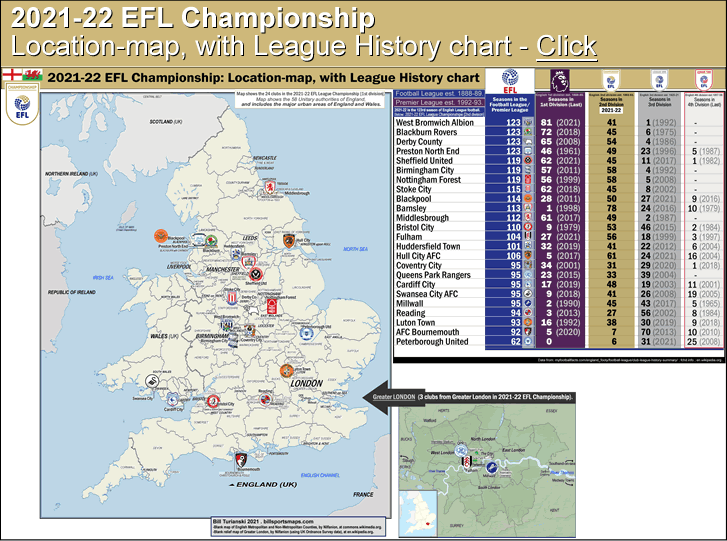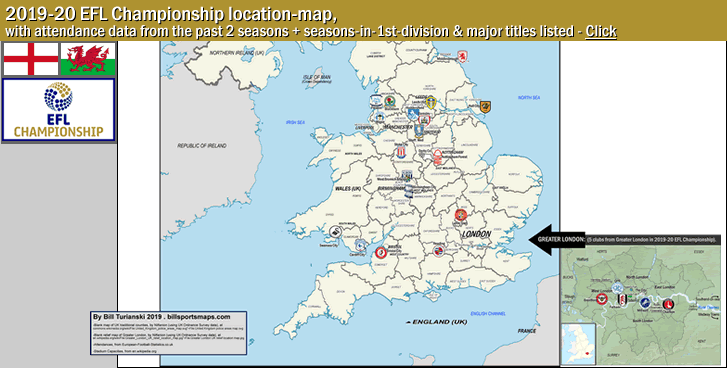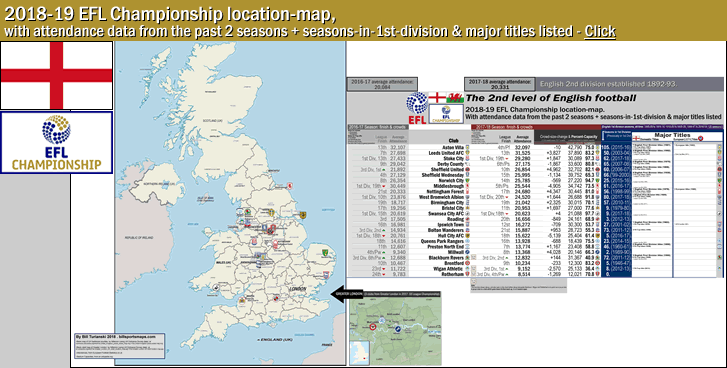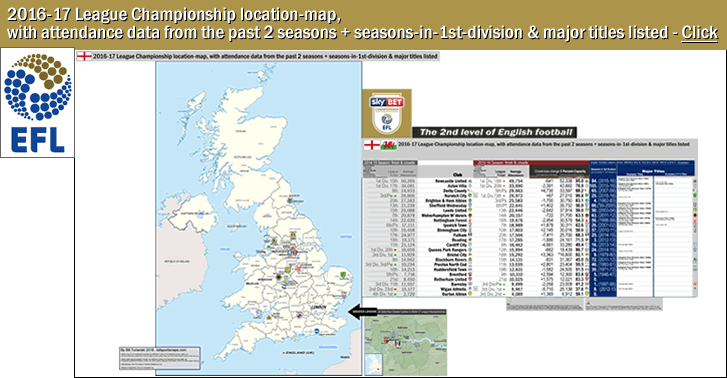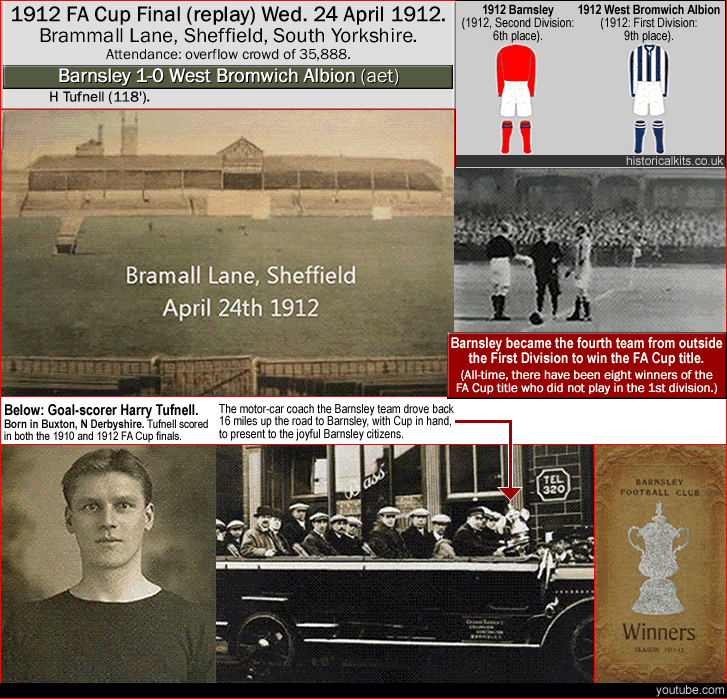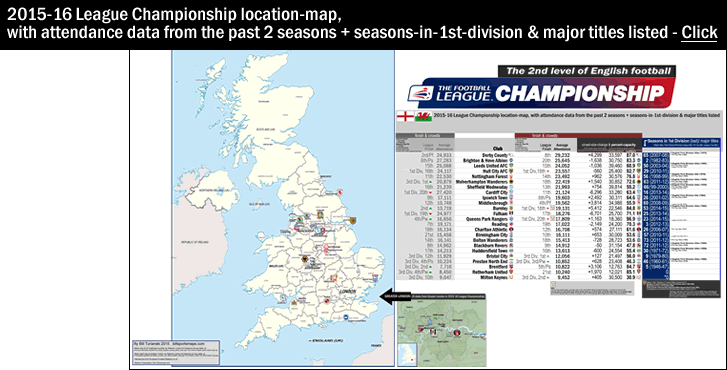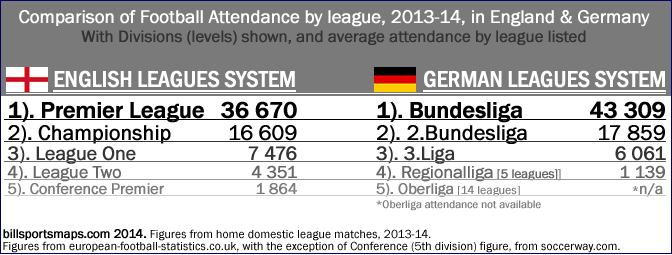
2017-18 Football League Championship (2nd division England, incl. Wales): map w/ 16/17-crowds-&-finish + titles-&-seasons-in-1st-division
…
…
By Bill Turianski on 2 August 2017; twitter.com/billsportsmaps.
Links…
-2017-18 Football League Championship (en.wikipedia.org).
-Table, fixtures, results, attendance, stats…CHAMPIONSHIP [Summary] (soccerway.com).
-Sky Bet Championship 2017 – 2018 [kits] (historicalkits.co.uk).
-EFL Championship preview 2017-18 (thesetpieces.com).
-Championship 2017-18 season preview (by Ben Fisher at theguardian.com/football/blog).
…
A brief re-cap of the 2016-17 League Championship [the 2nd division]…
Promoted…Newcastle United, Brighton & Hove Albion, Huddersfield Town {see this post [17/18 Premier League, featuring Newcastle, Brighton & Huddersfield]}.
Relegated from the Premier League down to the 2nd division are…Hull City, Middlesbrough, and Sunderland. Hull City and Middlesbrough both went back down to the 2nd tier after a one-season-spell in the Premier League, while Sunderland are back in the 2nd tier after a 10-season-spell in the Premier League.
Promoted up from the 3rd division and into the 2nd division are the three clubs profiled below…
Below: the 3 promoted clubs to the 2017-18 EFL Championship (England, 2nd division)
(Sheffield United, Bolton Wanderers, Millwall)…
Sheffield United won the 2016-17 EFL League One [3rd division], winning automatic promotion back to the Championship, after 6 seasons stuck in the 3rd division. Bolton Wanderers won the other automatic promotion, by finishing in 2nd place, thus bouncing straight back to the 2nd division on the first try. The third promotion place went to Millwall, who won the 2017 League One play-off Final, beating Bradford City 1-0 at Wembley. Millwall returns to the 2nd tier after 2 seasons in the 3rd tier.
• Sheffield United FC.
Est. 1889. Nickname: the Blades. Colours: Red-and-White vertical striped jerseys, Black pants and Black trim. Location: Sheffield, West Yorkshire, situated (by road) 35 miles (57 km) S of Leeds; and situated (by road) 169 miles (272 km) N of London. Distance between Sheffield United (Bramall Lane) and Sheffield Wednesday (Hillsborough Stadium) is 3 miles (5 km) {sportmapworld.com}. Population of Sheffield: city-population of around 518,000; urban-area population of around 685,000 {2011 census figures}. Sheffield, along with Rotherham and adjacent towns, is part of the Sheffield Built-Up Area, which is the 10th-largest Urban Area in the UK. {Source: en.wikipedia.org/wiki/List_of_urban_areas_in_the_United_Kingdom.}
Question: Why is Sheffield United nicknamed the Blades? Answer: Because of the large role that the steel industry and the cutlery-making industry have had in Sheffield. {see: Steel-making industry in Sheffield, a section in the illustration, further below.} Excerpt from Wikipedia…“The steel industry [of Sheffield] dates back to at least the 14th century. In 1740 Benjamin Huntsman discovered the crucible technique for steel manufacture, at his workshop in the district of Handsworth [in south-eastern Sheffield]. This process had an enormous impact on the quantity and quality of steel production and was only made obsolete, a century later, in 1856 by Henry Bessemer’s invention of the Bessemer converter which allowed the true mass production of steel. Bessemer had moved his Bessemer Steel Company to Sheffield to be at the heart of the industry. Thomas Boulsover invented Sheffield Plate (silver-plated copper), in the early 18th century. A major Sheffield steel invention was that of stainless steel by Harry Brearley in 1912, and the work of Profs. F. B. Pickering and T. Gladman throughout the 1960s, ’70s, and ’80s was fundamental to the development of modern high strength low alloy steels.”…{-from en.wikipedia.org/wiki/Economy_of_Sheffield}.
-Here is an article on Sheffield’s industrial past, and archeological research on that subject, Steel City: an Archaeology of Sheffield’s Industrial Past (hrionline.ac.uk).
Sheffield United have spent 60 seasons in the 1st division (last in 2006-07). Counting 2017-18, Sheffield United have spent 115 seasons in the Football League/Premier League. Sheffield United were created in 1889 because the cricket team who played at Bramall Lane, Sheffield United Cricket Club (est. 1854), needed to find a new renter, because their previous renter, the football club The Wednesday [Sheffield Wednesday], had moved to a new ground nearby…“Sheffield Wednesday…had vacated Bramall Lane after a dispute over rent. It was at this time that the now infamous ‘Pig’ nickname was aimed at the club by their Wednesday counterparts in reference to Pig Iron, an intermediate product in Steel production, hinting that Wednesday were there first so they were the Steel of the City and United were the Pig Iron.”…{-excerpts from Sheffield United F.C./Name origins_and nicknames, and en.wikipedia.org/History of Sheffield United F.C.}.
Sheffield United have not played in the same division as Sheffield Wednesday for five years (last in 2011-12, when both were in the 3rd division). So I thought it was a good time to post this small map (below), which shows the locations of Bramall Lane (near the Sheffield city centre), Hillsborough (in the Owlerton district in NW Sheffield), and Olive Grove. Olive Grove was the ground that The Wednesday left Bramall Lane for, and played at, for twelve years in the late nineteenth century (1887-99). Olive Grove was very close nearby to Bramall Lane, both just to the south of Sheffield city centre. So, in the late nineteenth century, Wednesday and United were playing within a half-mile of each other. Now they are a bit more separated…the distance between Sheffield United’s Bramall Lane and Sheffield Wednesday’s Hillsborough is 3 miles (5 km).
Venues of Football League clubs from Sheffield, South Yorkshire: Sheffield Wednesday (est. 1867). Sheffield United (est. 1889).
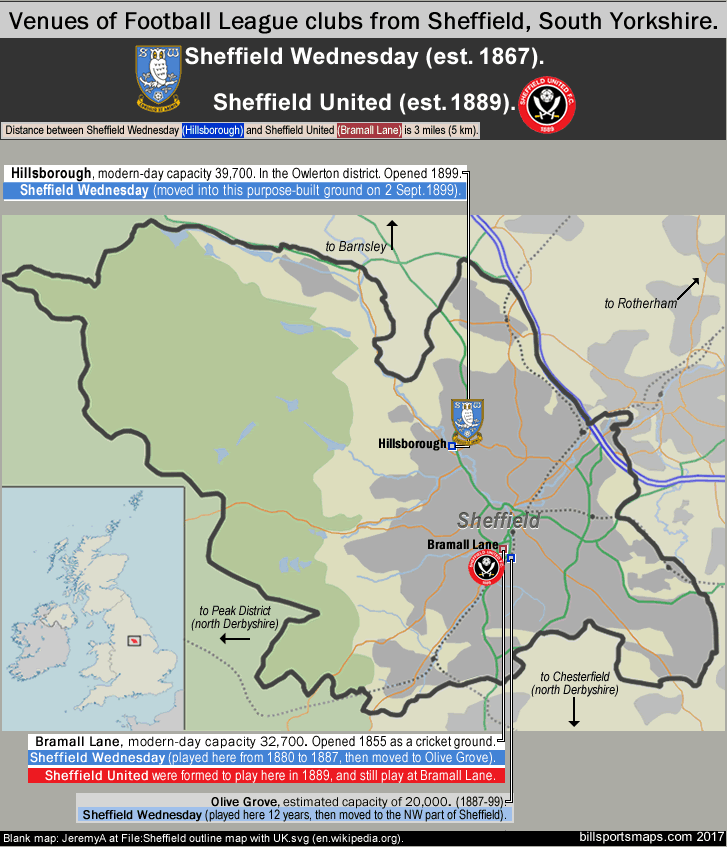
Image credit above – blank map of Sheffield by JeremyA at File:Sheffield outline map with UK.svg (en.wikipedia.org).
Sheffield United were one of the clubs which comprised the new Second Division, in 1892-93. (1892-93 was the fifth season of the Football League.) Sheffield United were elected to join the First Division for the following season of 1893-94. Sheffield United won their first and only English title in their fifth top-flight season, in 1897-98, finishing 5 points ahead of Sunderland. Here is an excerpt, about Sheffield United’s title-winning season of 1897-98, from the Sheffield Football.co.uk site’s page on SUFC…“United had become a real spectators team pulling in large audiences to not only watch the football but the characters on the pitch such as Bill “Fatty” Foulke the heavyweight goal keeper, Ernest Needham and Walter Bennett. In their first home game of the [1897-98] season against Derby a 2-1 victory drew in crowds of 2,500 and a month later 10,000 watched a 4-3 victory over Stoke. Sheffield managed a staggering unbeaten run of 14 matches until a mid season slump and a draw against rivals Wednesday in front of 37,289 fans. But after regaining form in the New Year, Sheffield United beat league rivals for the top spot Aston Villa in a monumental game in front of 43,000 spectators.” {-excerpt from History of Sheffield United (sheffieldfootball.co.uk/history-of-sufc).}
A season later (1898-99), Sheffield United won its first FA Cup title, with a 4-1 win over Derby County, before 70 thousand at the Crystal Palace in South London. Sheffield United won 3 more FA Cup titles (in 1902 over Southampton 2-1, in the replay at the Crystal Palace; in 1915 over Chelsea 3-0 at Old Trafford in Manchester; and in 1925 over Cardiff City 1-0 at Wembley). Sheffield United’s best finish in the post-War era was in fifth place, and this happened twice: in 1961-62 and in 1996-97. The Blades have not been in an FA Cup final since 1936 (losing to Arsenal 1-0). The Blades last time in the top-flight was a one-season-spell that ended disastrously in May 2007, when they needed to win their final game to secure safety, but lost to Wigan at home, while West Ham won away versus Manchester United. The way West Ham won that game was salt in the wound for Blades fans, because the winning goal scorer was Carlos Tevez, who was playing for West Ham under illegal circumstances (third-party ownership was involved in the Tevez transfer). But in the weeks that followed, the football authorities only saw fit to slap West Ham with a cash penalty – instead of the points deduction that the premeditated breach of rules deserved. So the cheating West Ham stayed up. And Sheffield United were relegated unfairly. Then Sheffield United got relegated again four seasons later, to the third division, in the spring of 2011.
Manager of Sheffield United: Chris Wilder (age 49, born in Sheffield; Wilder was a defender who played for Sheffield United from 1986-92 and in 1999).
After 6 seasons stuck in the 3rd division, it all came together for Sheffield United under Sheffield-born manager Chris Wilder. Wilder, who had made his name getting Oxford United back into the Football League (in 2010), took over the reins at Sheffield United in May 2016. This was just after Wilder had performed a stunning turn-around at Northampton Town, saving the relegation-threatened and cash-strapped Cobblers from almost-certain relegation (in 2014-15), then turning them into the 2015-16 League-Two-champions – all in a space of 16 months.
With Sheffield United, Wilder again put together an effective squad. Sheffield United ended up winning the 3rd division title with ease, finishing 14 points above Bolton, and 18 points above 3rd place. They clinched automatic promotion with 4 games to spare, on 8 April 2017, away to Northampton {see images below). Two Blades players made the 3rd division {EFL League One Team of the Year}, FW Billy Sharp and MF John Fleck. The 31-year-old Sheffield-born Billy Sharp, back in his second spell with the Blades after an uninspiring stint at Leeds United, netted a league-best 30 goals in 2016-17. The Glasgow-born John Fleck (age 25) had 17 assists (and 4 goals). That 17 assists was good enough for joint-best in the 3rd division (along with Peterborough’s Marcus Maddison). John Fleck also scored the promotion-clinching goal {see screenshots below}.
In 2010-11 Sheffield United were drawing 20.6 K when they were relegated to the 3rd tier. In the 3rd division (2011-17) the Blades drew…18.7 K, 18.1 K, 17.5 K, 19.8 K, 19.8 K, and last season 21.8 K. As they were drawing 8-and-9-years-ago, Sheffield United will probably draw in the 25-26-K range now that they are back in the 2nd division.

Photo and Image credits below – 16/17 Sheffield Utd jersey, photo from uksoccershop.com.File:Sheffield skyline.png, photo by St BC at commons.wikimedia.org. Central Sheffield, photo from sheffield-made.com. Original Bessemer Converter crucible, photo by Wikityke at File:Bessemer Converter Sheffield.jpg (commons.wikimedia.org). Mural of Harry Brearley by Faunographic/photo from creativetourist.com/articles/design/sheffield/the-making-of-a-metal-magnate-harry-brearley-stainless-steel-street-art. Painting of foundry in Sheffield, image from Sheffield Local Studies Library (Picture Sheffield Collection) via sheffieldindexers.com/SheffieldSteelWorks. Sheffield stainless steel cufflinks, photo from sheffield-made.com. Aerial shot of Bramall Lane, photo unattributed at embed.scribblelive.com/[Sheffield United/Blades Wall (message board)] jpg. Exterior shot of Brammal Lane main entrance, photo by Richard Barrett-Small [CC BY 2.0] at Wikimedia Commons via football-stadiums.co.uk/grounds/england/bramall-lane. Fans at Bramall Lane celebrating a goal [18 Feb. 2017 v Scunthorpe], photo by Simon Gill for When Saturday Comes at Photo of the week ~ Sheffield United fans celebrate against Scunthorpe (wsc.co.uk). John Fleck, photo by Pete Norton/Getty Images at zimbio.com. Billy Sharp, photo by Pete Norton at gettyimages.com. 16/17 Sheffield Utd away jersey, photo from uksoccershop.com. Promotion-clinching goal [4 April 2017 away to Northampton], 2 screenshots of video uploaded by Kezza Blade at PROMOTION AT LAST (Sheffield United seal promotion at Northampton) (youtube.com). Captain Billy Sharp and manager Chris Wilder (with trophy), photo by Tim Goode/PA Images via gettyimages.com.
…
• Bolton Wanderers FC.
Est. 1874. Nicknames: the Trotters, the Wanderers, the Whites. Colours: White jerseys, often with Dark-Blue pants and Dark-Blue-and-Red trim. Location: Horwich, which is 5.8 miles (9.3 km) NW of Bolton, in Greater Manchester. (Note: Bolton is historically part of Lancashire, but is now officially part of Greater Manchester.). Bolton is situated (by road) 10 miles (16 km) NW of central Manchester; and situated (by road) 221 miles (356 km) NW of London. Population of Bolton: around 128,000 {2011 census}.
Bolton Wanderers were formed in 1874 as Christ Church FC. ‘The club left the location following a dispute with the vicar, and changed its name to Bolton Wanderers in 1877. The name was chosen as the club initially had a lot of difficulty finding a permanent ground to play on, having used three venues in its first four years of existence.’ {-excerpt from Bolton Wanderers F.C./Early history (en.wikipedia.org).} Bolton were a founding member of the Football League in 1888-89, along with eleven other clubs from the North of England and from the Midlands. Bolton Wanderers are one of 10 clubs that have played every season of League football (119 seasons as of 2017-18), meaning they were Football League co-founders in 1888-89, and have never been elected-out or relegated-out of the League. (Those ten clubs are: Aston Villa, Blackburn Rovers, Bolton Wanderers, Burnley, Derby County, Everton, Notts County, Preston North End, West Bromwich Albion, Wolverhampton Wanderers.)
Bolton Wanderers have played 73 seasons of 1st division football (last in 2011-12). Bolton have never won an English 1st division title, but have won 4 FA Cup titles. Their first FA Cup win was in the historic 1923 FA Cup Final , aka the White Horse Final…
Article: The White Horse Final
(1923 FA Cup Final: the first-ever match played at the original Wembley Stadium, attendance estimated at over 200,000)
Bolton Wanderers 2, West Ham United 0…
The match was played on 28 April 1923, and was the first FA Cup final to be played at the original Wembley Stadium in London (which operated from 1923 to 2000). It was, in fact, the first-ever match played at Wembley, and construction had only been completed four days earlier. The match ended up having a fantastically huge overflow crowd estimated as more than 200,000. {See photos and captions in the illustration below.} Because of the novelty of the brand-new and gigantic 127,000-capacity venue, vast droves from all over the country turned up…without tickets. And soon there were no more tickets to be had. So vast throngs started to simply push their way into the stadium. {Here is an aerial photo from that day (twitter.com/GreatestCapital [aerial photo of Wembley during 1923 FA Cup]).}
The crush forced people already in the stands to seek the safety of the pitch. So the match could not begin until the pitch was cleared of thousands and thousands of fans. And so policemen, along with mounted police, painstakingly cleared the overflow crowd off of the pitch. The ‘White Horse’ was a grey steed named Billie. It became famous for its work helping to clear the huge crowd off the touch-lines {see caption and images further below; see this article at the FA site, Wembley’s First Ever Match}. Excerpt from that link…“One police horse called ‘Billie’ had more success than most, probably because of its colouring, and the match subsequently became known as ‘The White Horse Final’. Its rider, PC George Scorey, recalled the scene in a BBC Radio interview…
“The horse was very good, easing them back with his nose and his tail until we got the crowd back along one of the goal-lines. We continued up the touch-lines until some of them got a bit stubborn. ‘Don’t you want to see the game?’ I said. They said ‘Yes’ and I said ‘So do I. Now those in front join hands.’ Then I gave the word to heave and they went back, step by step, until they reached the line.”
It was virtually impossible to observe the laws of the game. When a player took a corner kick, for example, the crowd was so close to the touch-line that he could not take his run until a policeman had forced people away from that corner of the field”…{-excerpt from wembleystadium.com/The-First-Ever-Match-At-Wembley.}
In the aerial photo at the top of the illustration below, you can see how the process of clearing the crowd from the playing field had begun (three corners of the pitch have been cleared, while stragglers fill the other part of the field). Once the playing field was more-or-less cleared, there was basically no room between the fans and the playing-rectangle, and fans encroached onto edges of the pitch the whole game. Once the match finally started, there was a goal right away. Inside-Right David Jack scored for Bolton in the 2nd minute. (David Jack, who was born in Bolton, scored 144 goals for Bolton [1920-28] and 114 goals for Arsenal [1928-34].) The goal occurred when West Ham Half-Back Jack Tresadern had become entangled in the crowd while attempting a throw-in. Before he could get back onto the field, the ball was sent into the West Ham United penalty box, where Bolton Half-Back Jimmy Seddon won possession and then passed to David Jack. Jack feinted a pass, then dribbled close to the goal and scored with a hard shot into the right-hand-corner of the net. A spectator, who was pressed right up against the goal net, was knocked unconscious by the ball. Eleven minutes in, the crowd surged forward again, and a large number of fans were back on the pitch, leading to the suspension of play while the mounted police again cleared the pitch.
At halftime, the teams could not exit the field for the dressing rooms, and the break was only 8 minutes. Right after the second half, West Ham nearly scored. Then Bolton took a 2-0 lead, when, in the 53rd minute, Glasgow-born Bolton Centre-Forward Joe Smith received a pass from Welsh Winger Ted Vizard, and volleyed the ball against the underside of the cross-bar. The ball then slammed back down to the pitch in an almost-perpendicular way. West Ham players insisted the ball did not completely cross the line, but the referee said it did, and the goal stood. Bolton was up 2-0, and that was how the score remained, with very few scoring chances by either side in the final 30 minutes of the match…and Bolton Wanderers had won their first major title, in very remarkable circumstances. West Ham, the swifter and more attack-oriented of the two teams, were hampered by the churned up field…West Ham trainer Charlie Paynter blamed his team’s defeat on the damage the pitch had suffered before kick-off, saying “It was that white horse thumping its big feet into the pitch that made it hopeless. Our wingers were tumbling all over the place, tripping up in great ruts and holes”. {-excerpt from 1923 FA Cup Final/Summary (en.wikipedia.org).}
Only 22 people at the match were injured enough to be hospitalised, but the London Times estimated there were over a thousand who were slightly injured. Two policemen were also injured. But, amazingly, no one died. An official inquiry was considered, but the House of Commons praised the entire way the Metropolitan Police handled the incident. The FA re-imbursed ticket holders who claimed to have never reached their seats. Officials also publicly stated that had it not been for PC Scorey and his white horse, The Final might never have gone ahead that afternoon. And the FA started doing something different after that…they started selling advance tickets to big matches, beforehand.
Bolton won two more FA Cup titles in the 1920s – in 1926 (winning 1-0 over Manchester City) and in 1929 (winning 2-0 over Portsmouth). Charles Foweraker was at the helm when Bolton won their 3 FA Cup titles in the 1920s (Foweraker was Bolton manager for 25 years [1919-44]). Three decades later, Bolton won their last major title, winning the 1958 FA Cup Final, 2-0 over Manchester United. Bolton’s 1958 FA Cup title was won with Bill Ridding as manager (Ridding was Bolton manager for 18 years [1950-68]). Bolton Wanderers’ highest-ever league-placement was at 3rd place (in 1890-91, in 1920-21, and in 1924-25). Their best post-War league-finish was in the season after their last Cup-triumph, in 1958-59, finishing in 4th place. The best-1st-division-finish that Bolton have had in the Premier League era (since 1990-91), was in 6th place in 2004-05 under manager Sam Allardyce. Bolton’s last spell in the top flight was an eleven-season-spell from 2001-02 to 2011-12.
Below: Bolton’s first FA Cup title was won in the famous 1923 FA Cup Final (aka the White Horse Final)…

Photo and Image credits above – 1923 FA Cup Final, Bolton & West Ham kits, illustrations by Historical Football Kits site at historicalkits.co.uk/English_Football_League/FA_Cup_Finals/1920-1929. Vast overflow crowd at the new Wembley (1923 FA Cup Final], photo from mirror-photos.co.uk/west-ham-v-bolton-fa-cup-final-1923. Crowd near a goal-mouth prior to being pushed back, photographer unknown/Scanned in from The History of the Wembley FA Cup Final by Andrew Thraves at File:White Horse Final1923.jpg (commons.wikimedia.org). The White Horse keeping crowd at bay, screenshot from video at youtube.com via yahoo.com/blogs; photo unattributed at dailymail.co.uk/gallery. Cops keeping crowd back with Bolton players watching, photo unattributed at sports.yahoo.com/blogs/soccer-dirty-tackle/spectacular-images-madness-first-fa-cup-final-wembley. Action-shot, photographer unknown/Scanned in from The History of the Wembley FA Cup Final by Andrew Thraves at File:White Horse Final1923.jpg (commons.wikimedia.org). David Jack, trading card from flickr.com/cigcardpix <. Bolton crest from 1920s, from historicalkits.co.uk/Bolton_Wanderers. Bolton team (1923 FA Cup team), photo unattributed at spartacus-educational.com/WHcup1923. Joe Smith (captain) with FA Cup, photo by Bob Thomas/Popperfoto via gettyimages.com.
…
Manager of Bolton: Phil Parkinson (age 49, born in Chorley, Lancashire).
It might have come as a surprise to some that Phil Parkinson left the relative safety of the Bradford City set-up to take over the mess that Bolton Wanderers had gotten into. When Parkinson took the Bolton manager’s job in June 2016, Bolton had just been relegated – finishing 19 points adrift at the bottom of the 2nd division table – and there were considerable financial problems there. This cash problem later manifested itself in instances of delayed salary payments for Bolton players during the 16/17 campaign. Plus there were boardroom squabbles. And a transfer embargo. And if you think it’s not so hard for former-top-flight-/potentially-20-K-drawing clubs to get out of the 3rd division and back into the upper leagues, ask Sheffield United about that. It just took Sheffield United 6 years to get out of the 3rd division. A decade ago, it took Leeds United 3 seasons to get out of the 3rd division. But it only took Bolton Wanderers one year.
Two Bolton Wanderers players made the EFL League One Team of the Year for 2016-17: centre-backs David Wheater and Mark Beevers {see photos below}. David Wheater was voted EFL League One Player of the Year. Bolton had the stingiest defense in the 3rd division, allowing just 0.78 goals per game (36 goals allowed). They needed that solid defense, too, because Bolton only scored 68 goals (joint-5th-best), and there was not a single Bolton player who scored in double-figures…their joint-top-scorers were the following four: DF David Wheater, FW Gary Medine, MF Josh Vela, and FW Zach Clough, all of whom scored 9 league goals. Top in assists for Bolton was 31-year-old Portuguese-born/London-raised MF/Right-Winger Filipe Morais {see photo below}. Morais followed Phil Parkinson over from Bradford City, joining on 2 Feb. 2017. Then Morais caught fire for Bolton, racking up 13 assists (and 2 goals) in just 19 league matches for Bolton. He won the March League One Player of the Month award, with 10 assists and two goals in just that month. Bolton sealed their promotion campaign on the final day of the 2016-17 League One season [30 April 2017], with a 3-0 home win over Peterborough at the 28.7-K-capacity Macron Stadium (formerly called the Reebok Stadium). So Bolton clinched automatic promotion by finishing in 2nd place, 4 points above Scunthorpe and Fleetwood. Attendance on that promotion-clinching day was 22,590. Which is a good sign that Bolton will probably start to see crowds returning back toward the 20-K-range, now that the Wanderers have bounced right back to the second division. Bolton has not drawn above 20 K since their relegation from the Premier League (2011-12).

Photo and Image credits above -
Bolton 16/17 jersey, photo unattributed at footyheadlines.com. View of Reebok Stadium [now called Macron Stadium] from Horwich, photo by Ed O’Keefe Photography at edwud.com. Phil Parkinson with League One Runners-Up trophy, photo Reuters via hitc.com. David Wheater, photo unattributed at skysports.com. Mark Beevers, photo by Pete Norton/Getty Images Europe via zimbio.com. Filipe Morais, photo from theboltonnews.co.uk.
…
• Millwall FC.
Est. 1885, as Millwall Rovers, in the Millwall area of the Isle of Dogs [a small industrial peninsula on the north bank of the River Thames in East London, and part of the London Docklands]. “Millwall Rovers were formed by the workers of J.T. Morton’s canning and preserve factory in the Millwall area of the Isle of Dogs in London’s East End in 1885” {-Millwall F.C./Beginnings and relocation}. / 1889: changed name to Millwall Athletic. / 1910: club moved from East London, to south of the Thames in South East London at New Cross [Lewisham borough], and began play at the Den [now referred to as the Old Den (1910-1993)]. / 1920: changed name to Millwall FC. / 1993: moved to an adjacent borough [Southwark], in Bermondsey, and began play at the New Den [now called the Den].
Nickname: the Lions. Colours: Navy-Blue-with-White. Location: Bermondsey, London Borough of Southwark, South London, situated (by road) about 5 miles (8 km) SE of central London. Population of London Borough of Southwark: around 313,000 {2016 estimate}.
2017-18 will be Millwall’s 91st season in the Football League. (Millwall joined the Football League when the Third Division was created, in 1920–21.) Millwall have been promoted eleven times and relegated ten times. The majority of their League time has been spent yo-yoing between the 2nd and 3rd divisions. Millwall have spent 5 seasons in the 4th division, 43 seasons in the 3rd division, and 41 seasons in the 2nd division (including 2017-18). Millwall spent two seasons in the 1st division (1988 to ’90), and had their best finish, of 10th place in the First Division, in 1988-89. That season (’88/89), they also drew their highest in the modern era, drawing 15.4 K. (Millwall’s all-time best crowd-size was in 1938-39, when they had just won promotion back to the Second division, drawing 27.3 K [11th best attendance in the Football League that season] {source}.) In 2004, Millwall made it to the FA Cup final (losing to Manchester United 3-0), and qualified for the following season’s UEFA Cup, playing in Europe for the first time in their history [in September 2004, versus Hungarian side Ferencváros, losing 4-2 aggregate]. The club have reached the FA Cup semi-finals in 1900, 1903, 1937, 2013. These days, Millwall averages between 9-to-11-K most seasons, and drew 9,340 last season [2017-18]. The last time Millwall got promoted back to the 2nd tier, they drew 12.4 K (in the 2010-11 League Championship).
Map below:
Millwall FC’s locations: Isle of Dogs (London’s East End)>New Cross (Lewisham, SE London)>Bermondsey (Southwark SE London).
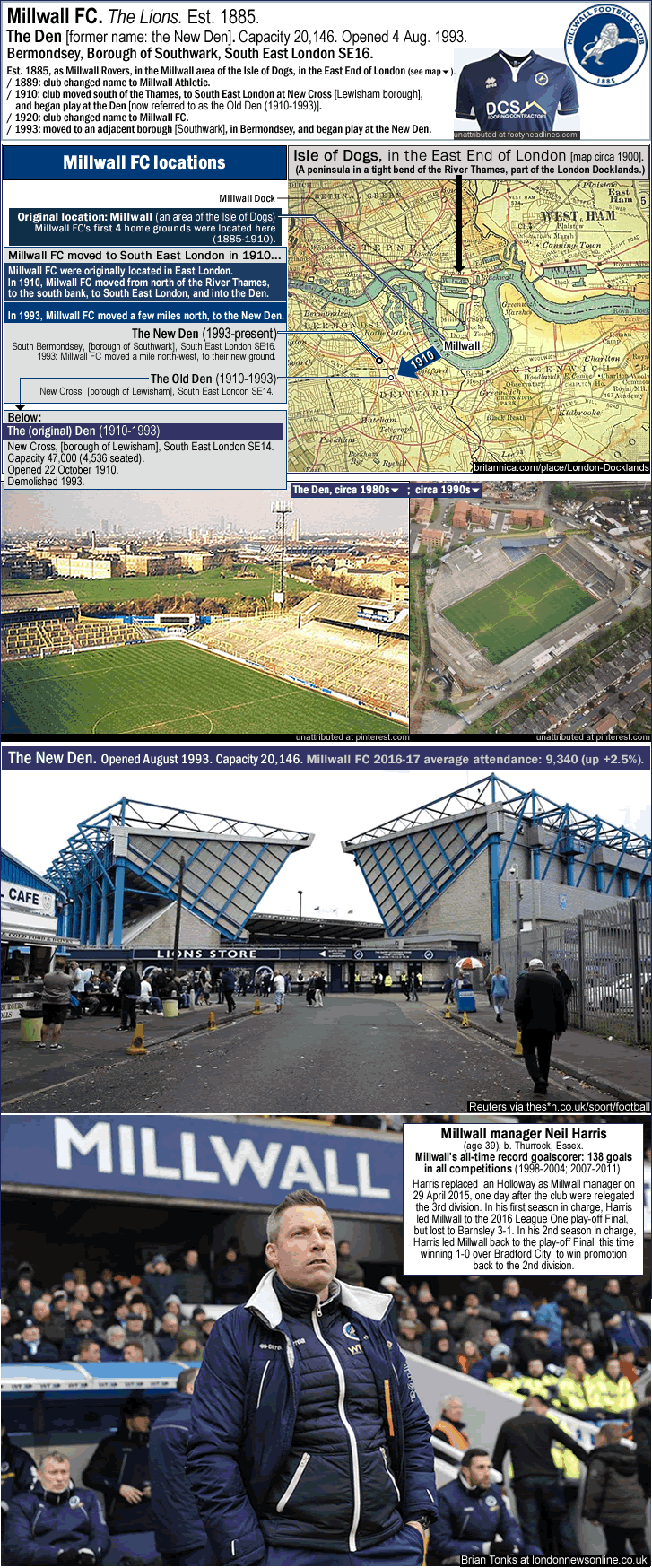
Photo and Image credits above – Millwall 17/18 jersey, unattributed at footyheadlines.com. Old map [ca. 1900] of Isle of Dogs in London Docklands, from Encyclopedia Britannica at britannica.com/place/London-Docklands. Aerial shots of the Old Den, photos unattributed at pinterest.com/Millwall/old English stadia]; pinterest.com/[old English stadia]. Exterior shot of the New Den, photo by Reuters via thes*n.co.uk/football. Neil Harris, photo by Brian Tonks at londonnewsonline.co.uk.
Manager of Millwall: Neil Harris (age 39; born in Orset, Thurrock, Essex). Harris is Millwall’s all-time record goalscorer, with 138 goals in all competitions (1998-2004; 2007-2011). After retiring from the pitch in June 2013, Harris joined the coaching set-up at Millwall. Harris replaced Ian Holloway as Millwall manager on 29 April 2015, one day after the club were relegated to the 3rd division. In his first season in charge, Harris led Millwall to the 2016 League One play-off Final, but Millwall lost to Barnsley 3-1. In his 2nd season in charge, Harris led Millwall back to the play-off Final, this time winning 1-0 over Bradford City, to win promotion back to the 2nd division. 33-year-old striker James Morison scored the winner in the 85th minute (see photo below). One Millwall player was selected for the 2017 League One Team of the Year, MF Lee Gregory (see photo below). The ex-FC Halifax Town striker has now scored 42 goals for Millwall in 114 league appearances (since 2014).
Below: 2017 League One play-off Final at Wembley: Millwall 1-0 Bradford City. Attendance: 53,320.
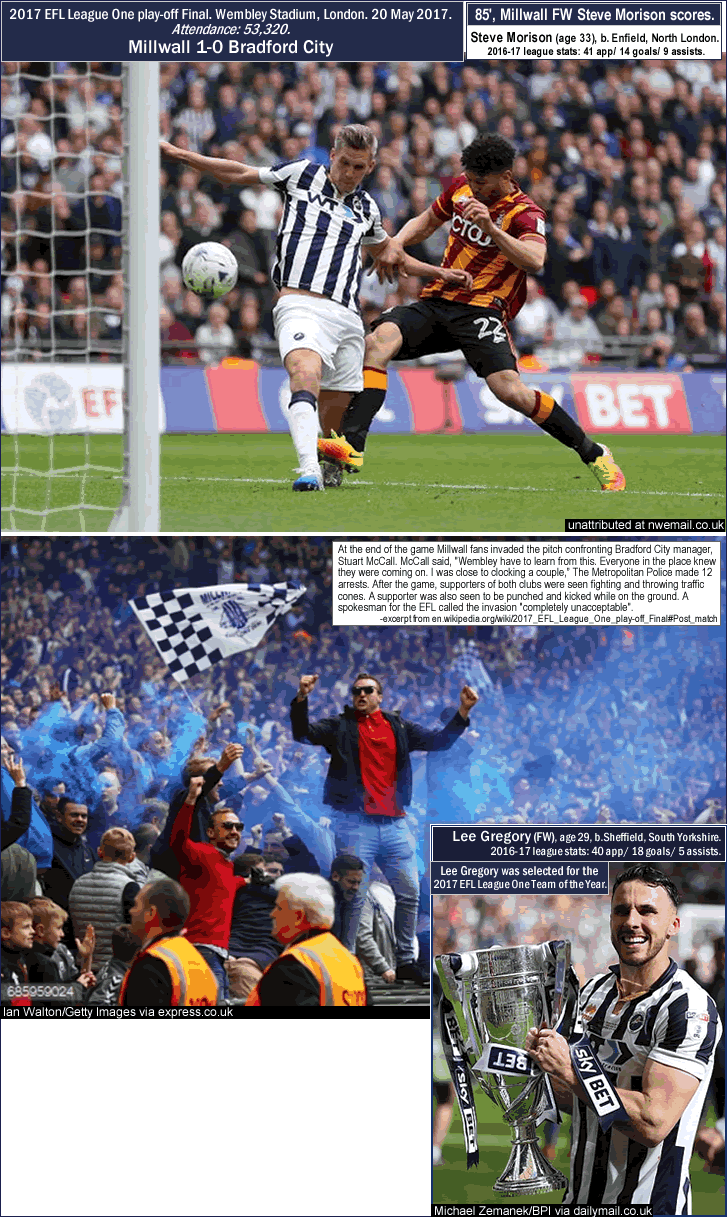
Photo and Image credits above – Steve Morison scores for Millwall in play-off Final at Wembley, photo unattributed at nwemail.co.uk. Millwall fans at Wembley May 2017, photo by Ian Walton/Getty Images via express.co.uk. Lee Gregory with trophy, photo by Michael Zemanek/BPI via dailymail.co.uk.
___
Thanks to the following…
-Blank map of UK historic counties, by Nilfanion (using UK Ordnance Survey data), at File:United Kingdom police areas map.svg (commons.wikimedia.org).
-Blank relief map of Greater London, by Nilfanion (using UK Ordnance Survey data), at File:Greater London UK relief location map.jpg.
-England – First Level All-Time Tables 1888/89-2015/16 (rsssf.com).
-Attendances from E-F-S site, european-football-statistics.co.uk/attn.htm.
Thanks to the contributors at en.wikipedia, at EFL Championship 2017-18.




